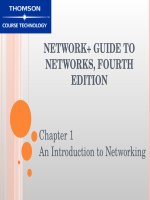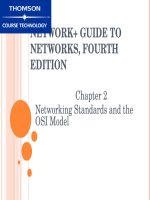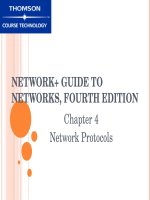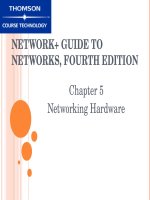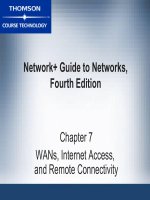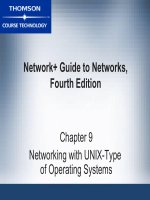Guide to network essentials 4th chapter 03
Bạn đang xem bản rút gọn của tài liệu. Xem và tải ngay bản đầy đủ của tài liệu tại đây (1.42 MB, 58 trang )
Chapter 3:
Networking Media
Learning Objectives
Define and understand technical terms relating
to cabling, including attenuation, crosstalk,
shielding, and plenum
Identify the major types of network cabling and
wireless network technologies
Understand baseband and broadband
transmission technologies and when to use each
Guide to Networking Essentials,
2
Learning Objectives (continued)
Decide what kinds of cabling and connections
are appropriate for particular network
environments
Describe wireless transmission technologies
used in LANs
Describe signaling technologies for mobile
computing
Guide to Networking Essentials,
3
Network Cabling: Tangible Physical Media
Media allows data to enter and leave computer
May be cabled or wireless communications
Interface between computer and medium defines
form for outgoing messages
Different kinds of media, both wired and
wireless, have limitations
Consider cost and performance when choosing
network cabling
Guide to Networking Essentials,
4
Primary Cable Types
Cables provide medium across which network
information travels either as electrical
transmissions or light pulses
Three most commonly-used kinds of network
cabling are:
Coaxial
Twisted-pair
(TP), both unshielded (UTP) and shielded
(STP) varieties
Fiber-optic
Guide to Networking Essentials,
5
General Cable Characteristics
All cables share these fundamental
characteristics:
Bandwidth rating
Maximum segment
length
Maximum number
of segments per
internetwork
Maximum number of
devices per segment
Guide to Networking Essentials,
Interference
susceptibility
Connection hardware
Cable grade
Bend radius
Material costs
Installation costs
6
Baseband and Broadband Transmission
Baseband transmissions use digital encoding
scheme at single, fixed frequency
Signals
are discrete pulses of electricity or light
Uses entire bandwidth of cable to transmit single data
signal
Limited to half-duplex (transmission only one direction
at a time)
Use repeaters to refresh signals before
transmitting them to another cable segment
Guide to Networking Essentials,
7
Baseband and Broadband Transmission
(continued)
Broadband transmissions are analog
Move
across medium as continuous electromagnetic
or optical waves
Flow only one way (simplex)
Needs two channels for computer to send and receive
data (full-duplex)
May operate multiple analog transmission channels
on single broadband cable
Amplifiers interlink cable segments to strengthen
weak signals and rebroadcast them
Guide to Networking Essentials,
8
Baseband and Broadband Transmission
(continued)
Broadband requires two channels to send and
receive
Two primary approaches to two-way broadband
communications:
Mid-split
broadband – uses single cable but divides
bandwidth into two channels, each on different
frequency
Dual-cable broadband – uses two cables
connected simultaneously to each computer
Broadband offers higher bandwidths than baseband,
but is generally more expensive
Simulation 3-1 shows baseband vs. broadband
Guide to Networking Essentials,
9
The Importance of Bandwidth
The faster the connection, the better
Video teleconferencing, streaming audio and
video, and other powerful services require
more bandwidth
As application developers build software
requiring more bandwidth, networks must supply
ever-higher amounts of bandwidth
Guide to Networking Essentials,
10
Coaxial Cable
Predominant form of network cabling for many
years
Was
Has single conductor at core, surrounded by
insulating layer, braided metal shielding (called
braiding), and outer cover (called sheath or jacket)
See
inexpensive and relatively easy to install
Figure 3-1
Less susceptible to interference and attenuation
than twisted-pair cabling
Guide to Networking Essentials,
11
Coaxial Cable (continued)
Guide to Networking Essentials,
12
Twisted-Pair Cable
TP is simply two or more pairs of insulated copper
wires twisted around each other
Improves
resistance to interference
Limits crosstalk
The more twists, the better
Two primary types of TP cable
Unshielded
twisted-pair (UTP)
Shielded twisted pair (STP)
See Figure 3-3
Guide to Networking Essentials,
13
STP and UTP Cable
Guide to Networking Essentials,
14
Shielded Twisted-Pair (STP)
Reduces crosstalk and limits external interference
Supports higher bandwidth over longer distances
Uses two pairs of 150 Ohm wire as defined
by IMB cabling system
Screened Twisted Pair (ScTP) or Foil Twisted Pair
(FTP) uses 100 ohm wrapped in metal
foil or screen; designed for electrically noisy
environments
Guide to Networking Essentials,
15
Twisted-Pair Connectors
Both STP and
UTP use RJ-45
connectors
Similar
to four-wire RJ11 connectors used for
telephone jacks
RJ-45 is larger and
uses eight wires
Guide to Networking Essentials,
16
Fiber-Optic Cable
Uses pulses of light rather than electrical signals
Immune to interference; very secure; eliminates electronic
eavesdropping
Excellent for high-bandwidth, high-speed,
long-distance data transmissions
Slender cylinder of glass fiber called core surrounded by
cladding and outer sheath, as seen in Figure 3-6
Plastic core makes cable more flexible, less sensitive to
damage, but more vulnerable to attenuation and unable to
span as long distances as glass core cables
Guide to Networking Essentials,
17
Fiber-Optic Cable (continued)
Guide to Networking Essentials,
18
Fiber-Optic Cable (continued)
Each core passes signals in only one direction
Most fiber-optic cable has two strands in separate
cladding
May
be enclosed within single sheath or jacket
or may be separate cables
Kevlar often used for sheathing
Advantages include no electrical interference,
extremely high bandwidth, and very long segment
lengths
See Table 3-2
Guide to Networking Essentials,
19
Fiber-Optic Cable Characteristics
Guide to Networking Essentials,
20
Fiber-Optic Cable (continued)
More difficult to install and more expensive than
copper media
Two primary types:
Single-mode
cables: cost more; span longer distances;
work with laser-based emitters
Multimode cables: cost less; span shorter distances;
work with light-emitting diodes (LEDs)
Used for network backbone connections and with
long-haul communications carrying large amounts
of voice and data traffic
Guide to Networking Essentials,
21
Cable Selection Criteria
Consider the following criteria when
choosing network cabling:
Bandwidth
Budget
Capacity
Environmental
considerations
Guide to Networking Essentials,
Placement
Scope
Span
Local requirement
Existing cable plant
22
Comparison of General Cable
Characteristics
Guide to Networking Essentials,
23
Wireless Networking: Intangible Media
Wireless technology is increasing
Becoming more affordable
Frequently used with wired networks
Microsoft
calls these hybrid networks
Guide to Networking Essentials,
24
The Wireless World
Capabilities of wireless networking:
Create
temporary connections into existing
wired networks
Establish back-up connectivity for existing wired
networks
Extend network’s span beyond limits of cabling
without expense of rewiring
Permit users to roam (also called “mobile networking”)
Guide to Networking Essentials,
25

